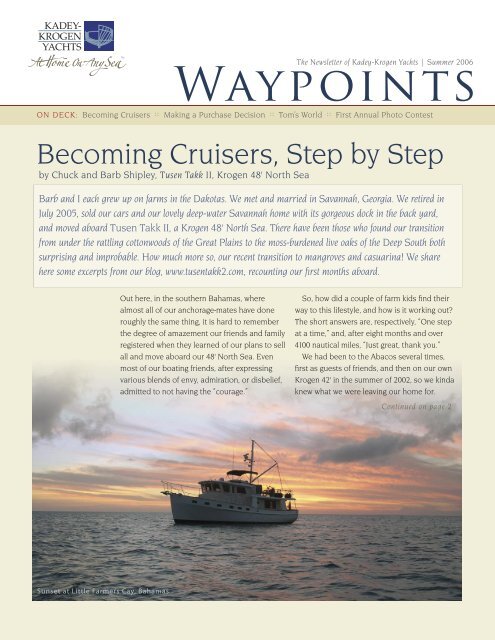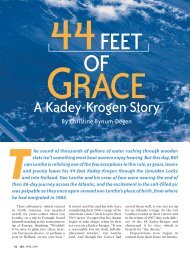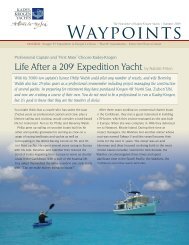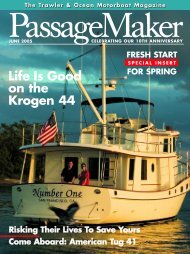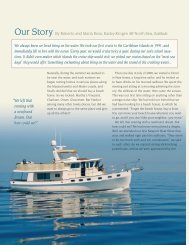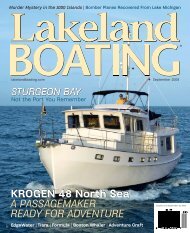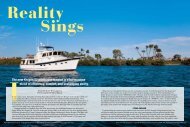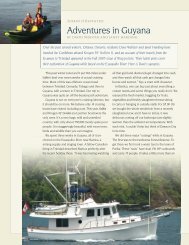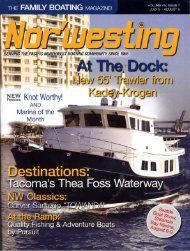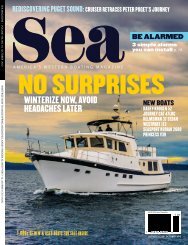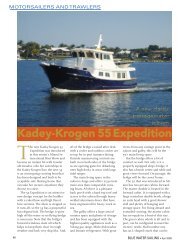Waypoints - Kadey-Krogen Yachts
Waypoints - Kadey-Krogen Yachts
Waypoints - Kadey-Krogen Yachts
You also want an ePaper? Increase the reach of your titles
YUMPU automatically turns print PDFs into web optimized ePapers that Google loves.
The Newsletter of <strong>Kadey</strong>-<strong>Krogen</strong> <strong>Yachts</strong> | Summer 2006<br />
<strong>Waypoints</strong><br />
ON DECK: Becoming Cruisers :: Making a Purchase Decision :: Tom’s World :: First Annual Photo Contest<br />
Becoming Cruisers, Step by Step<br />
by Chuck and Barb Shipley, Tusen Takk II, <strong>Krogen</strong> 48' North Sea<br />
Barb and I each grew up on farms in the Dakotas. We met and married in Savannah, Georgia. We retired in<br />
July 2005, sold our cars and our lovely deep-water Savannah home with its gorgeous dock in the back yard,<br />
and moved aboard Tusen Takk II, a <strong>Krogen</strong> 48' North Sea. There have been those who found our transition<br />
from under the rattling cottonwoods of the Great Plains to the moss-burdened live oaks of the Deep South both<br />
surprising and improbable. How much more so, our recent transition to mangroves and casuarina! We share<br />
here some excerpts from our blog, www.tusentakk2.com, recounting our fi rst months aboard.<br />
Out here, in the southern Bahamas, where<br />
almost all of our anchorage-mates have done<br />
roughly the same thing, it is hard to remember<br />
the degree of amazement our friends and family<br />
registered when they learned of our plans to sell<br />
all and move aboard our 48' North Sea. Even<br />
most of our boating friends, after expressing<br />
various blends of envy, admiration, or disbelief,<br />
admitted to not having the “courage.”<br />
So, how did a couple of farm kids find their<br />
way to this lifestyle, and how is it working out?<br />
The short answers are, respectively, “One step<br />
at a time,” and, after eight months and over<br />
4100 nautical miles, “Just great, thank you.”<br />
We had been to the Abacos several times,<br />
first as guests of friends, and then on our own<br />
<strong>Krogen</strong> 42' in the summer of 2002, so we kinda<br />
knew what we were leaving our home for.<br />
Continued on page 2<br />
Sunset at Little Farmers Cay, Bahamas
Tusen Takk II rests in Stampers Bay near Berkeley Island, Virginia.<br />
Continued from page 1<br />
“So we began<br />
looking for the<br />
right vessel, and<br />
were absolutely<br />
bowled over by the<br />
48' North Sea.”<br />
As retirement loomed closer, we came to<br />
realize that we really wanted to cruise extensively.<br />
So we began looking for the right vessel,<br />
and were absolutely bowled over by the 48'<br />
North Sea. We like the way she handles the<br />
seas; we appreciate the extra safety gained by<br />
cruising a vessel that is designed to take more<br />
punishment than we ourselves want to endure.<br />
We love the layout, the quality of the workmanship<br />
both inside and out, and the enormous<br />
amount of storage space on board. And more<br />
subjectively, we just love the way she looks.<br />
Were we apprehensive about our new<br />
venture? Not really. Prudence (and our insurance<br />
company) dictated that we head north<br />
along the Intracoastal Waterway, rather than<br />
setting out directly to the Caribbean, since<br />
hurricane season was upon us. The ICW above<br />
Charleston, SC, was all new territory to us, and<br />
we chose to traverse to the Chesapeake<br />
exclusively on the inside, so our transition was<br />
gradual. Of course, Murphy’s Law saw that we<br />
gained some valuable experience. We learned<br />
the exhilaration of waking to a violent thunderstorm<br />
and realizing that our vessel was dragging<br />
toward that of our companions; we<br />
learned that we could handle the crisis without<br />
permanent damage to our relationship; we<br />
learned that we could indeed reset the anchor<br />
in the wind and rain. (And we learned that we<br />
should install a larger anchor.) I had early<br />
opportunities to refresh my skills at changing<br />
the impellors on the propulsion engine and the<br />
genset. I learned that simultaneous “crazy”<br />
readings of oil pressure and temperature and<br />
2<br />
voltage do not signal Armageddon, but rather<br />
the need to tighten a grounding bolt on an<br />
engine block.<br />
Our transition to living aboard had been<br />
hectic, given we seriously downsized from our<br />
house to the boat. We were glad for the<br />
stateside chance to learn which clothes, galley<br />
utensils, supplies and tools we really needed.<br />
Preparations for Departure July 1, 2005<br />
The last two weeks before we departed were<br />
hell. We previously focused on giving the kids<br />
the good furniture, selling the sellable at a<br />
series of moving sales, giving the givable to<br />
Goodwill, and junking the rest, but we still had<br />
an enormous volume of stuff that we thought<br />
we wanted to take with us. So we had carried<br />
that all down to the dock, where it awaited<br />
loading onto the boat. We both labored until<br />
3:30 A.M. June 30-July 1 putting it all aboard, and<br />
then collapsed for a few precious hours before<br />
getting up to drive into Savannah for the house<br />
closing. When we arrived back in the driveway, a<br />
buyer was waiting to purchase our car–the last<br />
Ocracoke Island was<br />
one of the many<br />
scenic stops on the<br />
Shipleys’ ICW voyage.
of our disposables. Talk about last minute!<br />
We spent hours that afternoon securing the items<br />
that had been thrown aboard the night before,<br />
and putting the kayaks and bicycles on board. It<br />
was 5:30 P.M. by the time we left our dock. No<br />
longer “our” dock, really. We were tired. We were<br />
relieved. We went all of seven miles before<br />
anchoring on the Ogeechee River, not quite to<br />
Marker 98, and not quite to the Intracoastal<br />
Waterway, but definitely on our way to a whole<br />
new life!<br />
After sleeping like the dead on our first night on<br />
the hook, we had a leisurely breakfast and headed<br />
north. We met up with friends on their <strong>Krogen</strong> 39'<br />
and anchored near Daufuskie Island, southwest of<br />
Hilton Head, SC. They treated us to an on-board<br />
leg of lamb dinner followed by a champagne toast<br />
to celebrate our new life. Excellent! The next day<br />
we all got our kayaks down and went for a long<br />
paddle in the nearby creeks.<br />
(The above underscores one of the salient<br />
features of living aboard a <strong>Krogen</strong>: the fellowship<br />
with other <strong>Krogen</strong> owners. Already we have<br />
made many deep friendships. We’ve met and<br />
re-encountered a number of couples, and have<br />
cruised with one or more other <strong>Krogen</strong>s. But<br />
not just <strong>Krogen</strong>ites. Generally, cruising means<br />
meeting interesting people.)<br />
Onward to the Chesapeake<br />
Cruising up the ICW was fun. We enjoyed seeing<br />
the changes in the landscape and geography. Just<br />
north of Charleston, SC, the terrain changed<br />
almost immediately from the meandering tidal<br />
creeks that we had learned to love so much in<br />
Georgia, to be replaced by straighter man-made<br />
channels. That feature persisted all the way up to<br />
Southport, NC. What did change during this<br />
stretch, however, were the flora and the<br />
population density.<br />
North of Georgetown, SC, the ICW begins to<br />
angle off inland, and so the water gets less and<br />
less salty and more and more tannin-stained.<br />
Cypress trees and knees line the shores.<br />
Eventually the ICW angles back toward the<br />
sea. Approaching Myrtle Beach the ICW<br />
Chuck paddles among rock formations in the Berry Islands.<br />
morphs again, still tannin-stained, but now the<br />
narrower straight channels have been cut down<br />
to bedrock. Kinda scary, because the narrow<br />
passage with hard shoulders makes passing or<br />
meeting large vessels very problematical.<br />
You can read about our ports of call and<br />
anchorages from Georgia up to Virginia at<br />
www.tusentakk2.com.<br />
After 45 days of cruising, Chuck put the<br />
following in our log. Question: How do you<br />
spend your time when you are not actually<br />
traveling with the boat? Answer: Futzing,<br />
mostly. A little varnishing here. A little stainless<br />
steel polishing there. A little bottom cleaning. A<br />
little hull washing and waxing. Installing small<br />
improvements, like new hooks for hanging<br />
towels or new trumpet horns on the flybridge or<br />
adjusting the chart-reading light in the pilothouse.<br />
Reading one of the many systems<br />
manuals on board. Changing oil and<br />
filters. Cleaning through-hull filters. Changing<br />
zincs. But not always futzing. Sometimes, more<br />
actively recreating: tours, walks, runs, kayak<br />
explorations, and happy hours on board. I’ve<br />
read much less than I thought I would. Not<br />
enough time! But that will surely settle down as<br />
I spend less time “improving” and far less time<br />
Continued on page 4<br />
“One of the salient<br />
features of living<br />
aboard a <strong>Krogen</strong>:<br />
the fellowship with<br />
other <strong>Krogen</strong> owners.”<br />
3
Continued from page 3<br />
Got lobster?<br />
re-arranging all that we brought aboard–stuff<br />
that needed a home but hadn’t yet been<br />
assigned a place. The guest stateroom is now<br />
nearly clear enough to receive a guest!<br />
Excerpts from the Chesapeake<br />
We departed Regatta Point Marina, Deltaville,<br />
VA, back out the Rappahannock River to the<br />
Chesapeake for a short jaunt down to the<br />
Piankatank River. Seven miles up the Piankatank<br />
we found paradise, September 3. We<br />
anchored off Berkeley Island, and didn’t leave<br />
for a week! What did we do at one isolated<br />
anchorage for a whole week? Well, Chuck got in<br />
two long runs and two five-mile runs. We put<br />
down many coats of varnish on the cap rail.<br />
Barb took her bike nine miles back to Deltaville<br />
to pick up a new receiver box for our weather<br />
system, and later another ride to send the<br />
defective ones back, and later to get a<br />
haircut, buy vegetables, and secure a few<br />
varnishing supplies.<br />
On a Sunday just as we were about to sit<br />
down for breakfast, a center console runabout<br />
suddenly appeared at our stern. There were<br />
two men on board. One held a manila<br />
envelope. Were we about to be served<br />
with some kind of papers?<br />
Nope. Big smiles, and an<br />
explanation: they<br />
had been admiring<br />
our boat; had taken<br />
some pictures; were<br />
presenting a print of<br />
one of the pictures<br />
as a gift, and a CD<br />
with several others!<br />
How nice!<br />
After our <strong>Krogen</strong><br />
cruising companions Barb Shipley at Sugar Beach Cave<br />
left the anchorage<br />
on Labor Day, we had the glorious bay pretty<br />
much to ourselves for awhile. Eventually another<br />
vessel appeared. Interesting looking. We dropped<br />
by during a dinghy run to the public landing and<br />
learned that Ned, the single-handing skipper, had<br />
designed and built the steel-hulled vessel some 26<br />
years ago in Ohio, and had been living on her ever<br />
since. He has taken the vessel up the Tombigbee,<br />
up and down the east coast many times, and<br />
down through the Bahamas and Caribbean as far<br />
as the Dominican Republic. Interesting fellow.<br />
We pumped him for recommendations of<br />
anchorages off the Chesapeake, and learned that<br />
he had been on the first leg of the Great Loop (in<br />
the conventional counter-clockwise direction–up<br />
the east coast, through the Great Lakes and down<br />
the Mississippi) when a hurricane got in the way,<br />
and he had to duck into one of the Chesapeake’s<br />
many hidey-holes. That was the genesis of a new<br />
quest: to visit every one of the Chesapeake’s many<br />
side rivers. At the time we spoke, he had only<br />
three left.<br />
One day as Barb waited at the public landing for<br />
me to come get her and her bike, she spoke with<br />
two couples who had brought a sailboat down<br />
from New Jersey. As they were trailering the boat,<br />
they excitedly told of seeing bald eagles and their<br />
nest on Berkeley Island. A couple days later, we<br />
loaded onto the dinghy for some serious bird<br />
watching. This was Barb’s first real experience<br />
with her brand-spanking-new image-stabilized<br />
10x30 Canon beauties, and so she was even more<br />
eager than I to spy the eagles. It can be safely<br />
concluded that our New Jersey sailors were city<br />
slickers. We didn’t see any bald eagles, but we did<br />
see several osprey. Ospreys do have a certain<br />
4
amount of white on<br />
their heads. (But also<br />
a black mask, as well<br />
as other black<br />
areas.) The eagle<br />
nest turned out to be<br />
a large duck blind!<br />
We could hardly stifle<br />
the giggles sufficiently<br />
to steer the dinghy<br />
in the Berry Islands<br />
back to our boat.<br />
October 10, 2005:<br />
Anchored near Warehouse Point on the Indian<br />
Creek, on the north end of Fleets Bay, VA, just<br />
north of the Rappahannock. The trip had been<br />
blustery, making the absolute stillness of the<br />
picturesque anchorage all the more<br />
memorable. We sat in the warmth on the foredeck<br />
with a drink until the sun sank. Wow, it got chilly<br />
quickly. But not so quickly that we missed the<br />
sights and sounds of a flock of Canada geese<br />
passing just overhead in their ragged forked<br />
formation, talking among themselves in resonant,<br />
musical and loud but congenial “h-ronk, h-ronk.”<br />
We felt some reluctance to be soon leaving the<br />
beautiful Chesapeake Bay. The wide open waters<br />
of the Bay itself; the interesting rivers feeding into<br />
it; the charming creeks feeding into the rivers,<br />
with so many of the creeks featuring bucolic<br />
anchorages–all of this we would soon pass out of,<br />
and into the more restricted ICW.<br />
We’re in the subtropics now<br />
And so we did. Back down to Savannah for an<br />
extended Thanksgiving visit with friends and<br />
family, and then on down the ICW to No Name<br />
Harbor, just south of Miami, where we awaited a<br />
weather window with two other <strong>Krogen</strong>s for<br />
the crossing.<br />
We checked in with Bahama customs and<br />
immigration on January 12, 2006, and have been<br />
enjoying the subtropics ever since. What is so<br />
great about the Bahamas? The water! The fishing!<br />
The diving! The people, both locals and cruisers!<br />
The sky!<br />
Virtually every time we have traversed deep<br />
water, we have caught mahi-mahi. We’ve had<br />
some gorgeous snorkeling and scuba diving<br />
expeditions. We detoured to the upper Berry<br />
Islands while awaiting a weather window to cross<br />
the Tongue of the Ocean to Nassau, and discovered<br />
a very friendly settlement at Great Harbour:<br />
walk or run on the road, and everyone waves as<br />
they pass. We’ve had uncountable congenial<br />
Happy Hours with fellow cruisers, sometimes on a<br />
vessel and sometimes on a sandy shore after an<br />
announcement on the VHF. On several such<br />
occasions, when the horizon to the west stretched<br />
down to the sea, and there were no clouds, we<br />
were privileged to see the green flash! And at<br />
night, bright stars all the way down to the horizon.<br />
Cruising life is good!<br />
And what about the long run? After this<br />
shakedown cruise, we will return to the Northeast<br />
for the summer and then cruise to the Caribbean<br />
next winter, spending the following summer below<br />
the hurricane belt. We think the <strong>Krogen</strong> 48' North<br />
Sea is just about the perfect boat for these plans.<br />
Maybe one day we will become jaded, but for now<br />
we are still in love: We wish we had a dollar bill for<br />
every time we have found ourselves pausing as we<br />
dinghied away from her–pausing to look back and<br />
say “Damn, that’s a pretty boat!”<br />
” What is so<br />
great about the<br />
Bahamas?<br />
The water! The<br />
fi shing! The diving!<br />
The people, both<br />
locals and cruisers!<br />
The sky!”<br />
5


